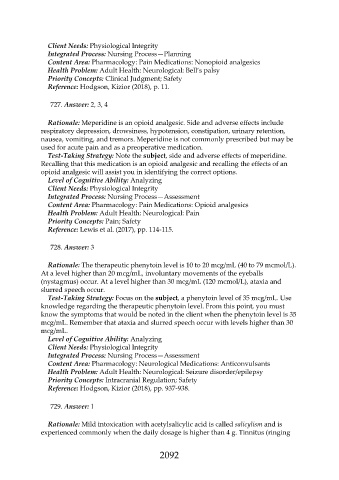Page 2092 - Saunders Comprehensive Review For NCLEX-RN
P. 2092
Client Needs: Physiological Integrity
Integrated Process: Nursing Process—Planning
Content Area: Pharmacology: Pain Medications: Nonopioid analgesics
Health Problem: Adult Health: Neurological: Bell’s palsy
Priority Concepts: Clinical Judgment; Safety
Reference: Hodgson, Kizior (2018), p. 11.
727. Answer: 2, 3, 4
Rationale: Meperidine is an opioid analgesic. Side and adverse effects include
respiratory depression, drowsiness, hypotension, constipation, urinary retention,
nausea, vomiting, and tremors. Meperidine is not commonly prescribed but may be
used for acute pain and as a preoperative medication.
Test-Taking Strategy: Note the subject, side and adverse effects of meperidine.
Recalling that this medication is an opioid analgesic and recalling the effects of an
opioid analgesic will assist you in identifying the correct options.
Level of Cognitive Ability: Analyzing
Client Needs: Physiological Integrity
Integrated Process: Nursing Process—Assessment
Content Area: Pharmacology: Pain Medications: Opioid analgesics
Health Problem: Adult Health: Neurological: Pain
Priority Concepts: Pain; Safety
Reference: Lewis et al. (2017), pp. 114-115.
728. Answer: 3
Rationale: The therapeutic phenytoin level is 10 to 20 mcg/mL (40 to 79 mcmol/L).
At a level higher than 20 mcg/mL, involuntary movements of the eyeballs
(nystagmus) occur. At a level higher than 30 mcg/mL (120 mcmol/L), ataxia and
slurred speech occur.
Test-Taking Strategy: Focus on the subject, a phenytoin level of 35 mcg/mL. Use
knowledge regarding the therapeutic phenytoin level. From this point, you must
know the symptoms that would be noted in the client when the phenytoin level is 35
mcg/mL. Remember that ataxia and slurred speech occur with levels higher than 30
mcg/mL.
Level of Cognitive Ability: Analyzing
Client Needs: Physiological Integrity
Integrated Process: Nursing Process—Assessment
Content Area: Pharmacology: Neurological Medications: Anticonvulsants
Health Problem: Adult Health: Neurological: Seizure disorder/epilepsy
Priority Concepts: Intracranial Regulation; Safety
Reference: Hodgson, Kizior (2018), pp. 937-938.
729. Answer: 1
Rationale: Mild intoxication with acetylsalicylic acid is called salicylism and is
experienced commonly when the daily dosage is higher than 4 g. Tinnitus (ringing
2092

